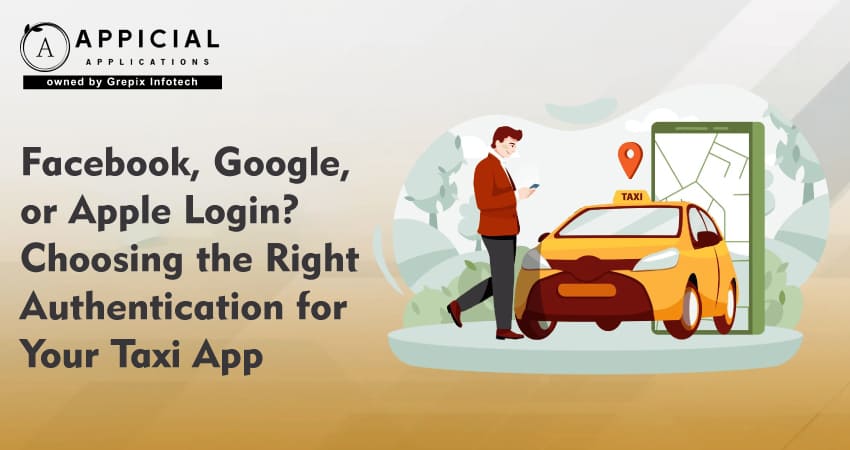
Facebook, Google, or Apple Login? Choosing the Right Authentication for Your Taxi App
As first-time users open a ride-hailing app for the first time, their initial action consists of signing up or logging in. It’s the make-or-break users' trust at that moment. If the login experience is poor or confusing the user will most likely abandon the app. Onboarding needs to be seamless because in these highly competitive markets, users make decisions in a matter of seconds.
Deciding whether to implement Facebook login, Google login, or Apple Sign-In is not exclusively a technical decision. It’s strategic. It impacts conversion rates, security, data privacy, and brand trust. This choice impacts user interaction from the very beginning, making it a key decision for anyone creating an Uber Clone, ride-sharing app, or e-hailing app.
Let’s explore what makes each option unique and how taxi app development companies and white label taxi app development companies can implement them efficiently.
Choosing between Facebook, Google, or Apple Sign-In is a key strategic decision for taxi and ride-hailing apps. It impacts user trust, onboarding speed, data privacy, and retention. Each login option offers unique advantages — Facebook for social reach, Google for Android integration, and Apple for privacy-focused iOS users. Successful taxi app development companies combine all three while following best practices: token security, SDK compliance, multi-factor authentication, and user-centric UI. A seamless, secure login flow reduces drop-offs and builds brand credibility. Appicial Applications provides scalable, white-label ride-hailing solutions with future-ready authentication systems tailored for Uber-clone and e-hailing apps.
Why Authentication Matters for Ride Apps?
In mobility applications, authentication is not simply identity; it is confidence. Passengers want to log in instantly and without friction. The process should also feel fast and secure for the drivers.
Apps like a ride-sharing app or a white label taxi booking app are custodians of private information like location, payment method, and phone numbers. Authenticated access protects against unauthorized use, and long-term trust is established. Social logins via Google, Facebook or Apple help this because now there is one less password to keep track of.
But, these two methods have each their own pros and cons. Grasping these subtleties aids taxi app development firms in providing secured user experiences.
Comparing Facebook, Google, and Apple Sign-In
Facebook Login
Facebook login gives users a familiar and fast way to register using existing social credentials. For developers building an Uber Clone or e-hailing app, integration is relatively straightforward through Facebook’s SDK.
Advantages:
- Instant recognition and broad adoption across demographics.
- Easy integration with profile pictures and basic user info.
- Reduced need for manual data entry.
Drawbacks:
- Some users distrust Facebook after past privacy issues.
- Requires frequent SDK updates and permission reviews.
- Not ideal for users who avoid social platforms.
Despite its drawbacks, Facebook login still works well for ride-hailing apps in emerging markets, where social engagement remains high.
Google Sign-In
Google Sign-In is one of the most widely used authentication systems worldwide. It fits naturally with Android-based ride-sharing apps and Uber Clones, where users are often already logged into their Google accounts.
Advantages:
- High trust factor and strong security infrastructure.
- Two-factor authentication support.
- Easy onboarding for Android users.
Drawbacks:
- Limited appeal to iOS-only users.
- Some corporate firewalls block Google authentication services.
For most white label taxi app development companies, Google Sign-In is a must-have due to its speed and reliability.
Apple Sign-In
Apple Sign-In is mandatory for all iOS apps that include third-party login options such as Facebook or Google. Its standout feature is the “Hide My Email” function, which adds a privacy shield for users.
Advantages:
- Privacy-focused, minimal data sharing.
- Simplified authentication using Apple ID.
- Seamless on all iOS devices.
Drawbacks:
- Limited analytics data due to masked email.
- Less relevant to Android-based apps.
For a ride-hailing app targeting iOS audiences, Apple Sign-In builds trust with users who prioritize data protection.
Factors That Influence Login Selection
Choosing one login system over another depends on multiple aspects:
- Target Platform: Android or iOS.
- User Demographics: Tech-savvy users vs. privacy-conscious ones.
- Security Requirements: Regulatory compliance and encryption standards.
- User Flow Design: How quickly users can request rides post-login.
- Platform Guidelines: Apple’s strict authentication policies.
Balancing these helps taxi app development companies decide whether to offer a single login or multiple options for flexibility.
What are the Best Practices for Integrating Authentication in a Ride Hailing App?
Effective authentication design is not just about functionality. It’s about anticipating human behavior and technical reliability. The following best practices guide developers when integrating Facebook, Google, and Apple login options in ride-hailing apps, Uber Clone apps, or white label taxi booking apps.
Offer Multiple Login Choices
Users have preferences. Some trust Google, others prefer Apple or Facebook. By offering all three, you maximize sign-up rates. This flexibility also improves user satisfaction.
Minimize Permission Requests
Avoid requesting too many permissions during initial login. A minimal permission set (name and email) encourages higher adoption rates. Request additional permissions only when necessary.
Ensure Platform Compliance
If you implement any other third-party logins, Apple requires the addition of “Sign in with Apple” as well on iOS. And, of course, always remain within Apple’s App Store policies to not get rejected.
Maintain Consistent UI Design
Each provider has brand guidelines for buttons and colors. Following these enhances credibility. Users instantly recognize familiar login icons, which reduces hesitation.
Implement Token Refresh and Expiry Handling
Access tokens expire. A robust refresh system ensures uninterrupted access without forcing frequent re-logins.
Secure Token Storage
Store authentication tokens only in encrypted form. For example, use Keychain on iOS and EncryptedSharedPreferences on Android.
Add Account Linking
Allow users to link multiple accounts (e.g., Google and Apple). If they switch devices, they should still access their profile and ride history easily.
Monitor Authentication Metrics
Track login success rates, error rates, and drop-off points. Data analytics reveal where users abandon the process so you can optimize the flow.
Provide Fallback Options
Not everyone wants to use social login. Include an alternative like phone-based OTP or traditional email-password login. This ensures inclusivity.
Update SDKs Regularly
Facebook, Google, and Apple frequently update their APIs for security improvements. Always use the latest SDK versions to avoid vulnerabilities.
By adhering to these best practices, any white label taxi app development company can ensure a secure, fast, and user-friendly login system.
What are the Implementation Guidelines for Taxi & Ride Apps?
Implementation is where planning meets precision. But, depending on their nature, authentication flows need to be designed to meet security standards as well as UX design principles. The following are step-by-step instructions to adhere to.
1 Stick to Official SDKs and APIs
Always use authentication via the official SDKs for Facebook, Google, or Apple. Included with these SDKs are token management, authentication flows that are secured, and error handling. Do not use libraries of third parties that could jeopardize data security.
2 Validate on the Server-Side
Client-side authentication should never be trusted. After the user has signed in, you should verify the token you received on your own backend server against the provider’s authentication API. This also ensures that the tokens have not been compromised.
3 Use two-factor authentication
In highly secure situations, such as for driver accounts, you may want to implement 2FA via SMS or email confirmation. This limits the possibility of accounts being hacked, even if credentials are compromised.
4 Encrypt all sensitive data
User tokens, emails, passwords and any other sensitive information should be stored with AES-256 or stronger encryption. Safeguard store credentials and do not retain extraneous personal data.
5Thoroughly test the OAuth flows.
Test all the edge cases: expired token, invalid token, revoked permissions, network outage etc. The gracefully degrading experience for users should be not crashing apps.
6 Implement Multi-device Syncing
Enable users to access their profiles from any device. This is especially beneficial for an Uber Clone or ride sharing app, where rides can be booked on a phone and tracked on a tablet.
Also Read: Taxi App Features | Taxi Booking App Features List
7 Include Account Recovery Options
Make it easy to reset the passwords or recover accounts that were tied through social logins. This builds trust and reduces support tickets.
8 Be Compliant with GDPR and Local Laws
If applicable, follow the procedures to collect consent or anonymize data, or to delete data as outlined by them. This is an important aspect for the deployment of white label taxi booking apps in regulated markets.
9 Construct Role Based Access Control RBAC
The ride hailing app used by both, drivers and passengers, is the same, but their permissions are different. Assign roles to avoid unwanted access to data across profiles.
10 Monitor and Audit Security Events
Log all authentication-related events, including failed login attempts, unusual patterns, or multiple failed OTP verifications. Regular audits prevent abuse and improve reliability.
Following these guidelines ensures your e-hailing app is both user-friendly and secure, meeting global standards expected from top taxi app development companies.
Why Good Authentication Makes for Good User Retention?
In fact, it’s been statistically shown how 68% of mobile app users abandon sign-up flows that take longer than 60 seconds. On top of that, 77% of respondents report that they are more likely to sign in with an option they know than to create a new account. This data demonstrates the importance of authentication to retention.
A simple “Sign in with Google” or “Sign in with Apple” button can reduce onboarding friction drastically. For a ride sharing app or Uber Clone, that translates to more completed signups and more rides booked per day.
Conclusion
The choice among Facebook login, Google login, and Apple Sign-In is not universal. Each platform has its pros and cons depending on your audience and device mix, as well as your privacy needs. The ideal would be for all three to be included in most if not all ride hailing apps or white label taxi booking apps to provide the user with the option and flexibility to choose.
When implementing these options, you need precision, compliance, and a strong backend framework. That’s where Appicial Applications excels.
As a leading taxi app development company and white label taxi app development company, Appicial Applications builds future-ready solutions with secure, scalable, and user-focused authentication flows. From Uber Clone development to enterprise-levele-hailing apps, our experts design login systems that improve user trust and drive retention.
Want to build a ride hailing app that’s secure, compliant, and user-friendly? Contact Appicial Applications today to get started.
FAQs
Author's Bio

Vinay Jain is the Founder at Grepix Infotech and brings over 12 years of entrepreneurial experience. His focus revolves around software & business development and customer satisfaction.
Back to blog list




